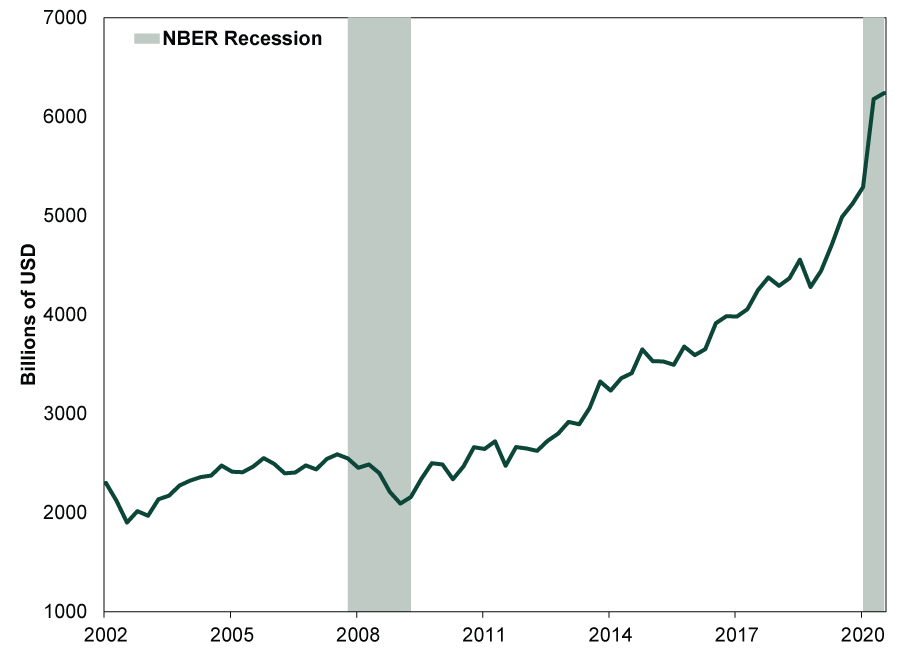Personal Wealth Management / Market Analysis
Why Savings Aren’t Necessarily Economic Rocket Fuel
Don’t presume massive savings will lead to surging spending.
As vaccine distribution becomes more widespread, many economists are becoming increasingly optimistic about economic growth. One factor underlying the excitement: Households are sitting on a massive pile of savings. Some see this as dry powder that will power an economic recovery for a long time to come. But households are unlikely to spend all these savings, and we think sentiment toward this alleged mountain of pent-up demand is a key place to watch for frothy expectations.
According to a recent Bloomberg analysis, households worldwide have accumulated $2.9 trillion in new savings since the pandemic hit, with the US comprising about half that amount ($1.5 trillion) as personal savings rates soared.[i] While the government’s direct household payments have contributed, the stockpile also reflects a lack of spending, particularly on services and travel, due to COVID restrictions.
Now, with economies poised to reopen more fully as vaccines roll out, some see these savings as jet fuel for economic growth. One research outfit estimates that if households ran down built-up savings in full, GDP could grow 9% in 2021.[ii] In that scenario, GDP would be about 5% higher than its pre-pandemic 2019 level.[iii] While possible, that extreme outcome seems a wee bit unlikely to us—especially since US GDP ended 2020 only -3.5% below pre-pandemic levels, and growth slowed in Q4 as the post-lockdown snapback ran its course.[iv]
Presuming households will spend all their savings and fuel a long boom when businesses reopen this time around seems premature. Yes, removing COVID restrictions will likely release some pent-up demand. We saw the economic data pop last year after states started lifting their initial lockdown measures in April and May. A similar phenomenon probably occurs again, though likely to a lesser degree since wintertime COVID measures weren’t as harsh relative to last spring’s. It also seems fair to say travel and leisure spending will get a boost as people take delayed vacations. But that is a far cry from drawing down the entire pool of amassed savings. There is no rule higher savings automatically predicts higher spending, as households could also pay down debt or keep a larger emergency cash stockpile.
That latter decision wouldn’t be unprecedented. Companies did something similar following the 2008 – 2009 financial crisis, as Exhibit 1’s look at corporate balance sheets shows.
Exhibit 1: US Nonfinancial Corporate Business Cash Levels Since 2002

Source: FactSet, as of 3/5/2021. Nonfinancial corporate business; liquid assets (broad measure), quarterly, in billions of US dollars. Q1 2002 – Q3 2020.
For years before the crisis, corporate cash on hand held fairly steady between $2.0 and $2.5 trillion. The crisis forced companies to draw down a chunk of that, but they quickly rebuilt it—and then kept on saving. That seems to us like a logical reaction, considering the financial crisis showed what happens when money markets are under stress and overall solvent companies lack liquidity and can’t get it in a pinch. The list of non-bank corporate casualties from that era is long, and even many survivors had to make deep cuts.
Corporate America saw the importance of a sufficient cash cushion to weather tough times and acted accordingly. Anyone seeing that cash as pent-up investment and economic rocket fuel proved sorely disappointed. We wouldn’t be shocked if consumers behaved similarly even in a vaccinated, post-COVID world now that we have all seen how quickly emergency government policies can strip people of their livelihoods.
From an investing perspective, we think cheery chatter about a potential household spending surge highlights today’s widespread optimism. But forward-looking stocks have likely already accounted for much of this widely discussed post-COVID spending. Keep this in mind if spending estimates continue climbing in the months ahead. It may signal investors’ expectations are getting ahead of reality—a potential sign of euphoria taking hold.
[i] “Consumers Saved $2.9 Trillion During the Pandemic. Their Money Will Drive the Global Recovery,” Simon Kennedy, Bloomberg, 3/2/2021.
[ii] Ibid.
[iii] Source: Bureau of Economic Analysis, as of 3/10/2021. Statement based on annual GDP levels for 2019 and 2020.
[iv] Source: FactSet, as of 3/10/2021. Statement based on percentage change in annual GDP level between 2019 and 2020.
If you would like to contact the editors responsible for this article, please message MarketMinder directly.
*The content contained in this article represents only the opinions and viewpoints of the Fisher Investments editorial staff.
Get a weekly roundup of our market insights
Sign up for our weekly e-mail newsletter.

You Imagine Your Future. We Help You Get There.
Are you ready to start your journey to a better financial future?

Where Might the Market Go Next?
Confidently tackle the market’s ups and downs with independent research and analysis that tells you where we think stocks are headed—and why.





